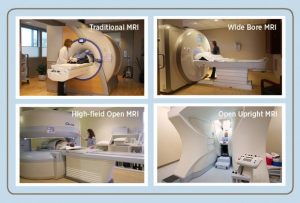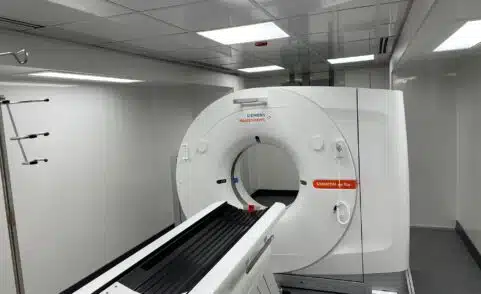
Does My MRI Fear Mean I am Truly Claustrophobic?
You may have never been diagnosed with a phobia, but if your doctor says you need an MRI your heart may start pounding. Many people describe the fear as claustrophobia, a word that comes from Latin claustrum which means “a shut in place” and Greek phóbos which means “fear.” If you feel fear of a shut in place like an MRI machine, does that mean you’re claustrophobic? Ask that question to Dr. Todd Farchione of Boston University’s Center for Anxiety and Related Disorders and he’ll ask you how distressing your fear is. To be classified as a phobia at the clinical level, your fear needs to be:
- Both distressing and impairing your life
- Outside the norm you’d expect given the threat
According to Dr. Farchione, just because you feel fear doesn’t mean you are clinically claustrophobic. “I do think it’s healthy to have a fear of getting trapped,” he explains. “But is the person really trapped? Can they get out?” When it comes to the case of an MRI exam, you are always able to stop and get out of the machine. A squeeze ball and two-way speaker puts you in communication with the technologist who is running your exam. If you need out, they will get you out. You are always in control.
How Common is Claustrophobia?
Research from the National Institute of Mental Health suggests that 2.5% of the U.S. population has Claustrophobia (fear of confined spaces). The book Phobias: A Handbook of Theory, Research and Treatment puts the estimate much higher – somewhere between 15% and 37% worldwide. This research suggests symptoms can vary widely and only a small percentage of those people seek treatment for claustrophobia. RAYUS Center Manager Desiree Rocovich says claustrophobia is common in the world of MRI. It’s so common that asking questions about it is standard in the pre-appointment screening call. “Four out of ten patients that we call will mention something about claustrophobia,” Desiree estimates.
If you’re wondering why you feel this fear, there’s no one answer for everybody. It could be a learned behavior. Perhaps you watched a parent react fearfully to certain situations, says Dr. Farchione. Or it might be a tendency to underestimate distances. Emory University psychologist Stella Lourenco has researched people with phobias and says those with higher levels of claustrophobia perceive things as being closer than they really are. Dr. Lourenco explains it in this video:
3 Ways to Deal with Claustrophobia
From drug therapy to hypnosis, there are a lot of ways you can approach conquering your claustrophobic fears to get the MRI you need. But here are 3 ideas to consider:
- Cognitive Behavioral Therapy
You can try this on your own or find a therapist who specializes in phobias. With Cognitive Behavioral Therapy you are learning to handle your fear. “What maintains the fear is avoidance,” says Dr. Farchione. “In treatment what we’re trying to do is to confront the thing they are afraid of instead of avoiding it.”
The techniques can be simple and straightforward. One Dr. Farchione recommends is exposures – meaning you are slowly experiencing the thing you are afraid of (in this case the MRI machine). Start by looking at pictures. Next try listening to a recording of the noise of an MRI machine. Then try listening to the recording while you are in a confined space like a dark closet. Eventually, through the exposures, you can train yourself to face the actual exam.
Other research reported in the journal Psychological Science found that a way to cure phobias is to watch others. The scientists at the Karolinska Institutet in Sweden say watching others experiencing your fear may be more effective than directly combating your own fear. Would watching other people getting an MRI make a difference for you?
For more ways you can use Cognitive Behavioral Therapy to conquer your claustrophobic fears, including creating your own fear ladder, click here.
2. Relaxation Exercises
When faced with the source of your fear, physical reactions are normal. It’s the fight or flight reaction. Learning ways to combat that response in your body can help you cope with claustrophobia. It might be a repeated mantra, a visualization, or a focus on breathing. Here’s one easy breathing exercise to try if you’re feeling anxiety before an appointment (or even if you’re just stuck in traffic):
3. Find an Alternative MRI Machine
You may find that a traditional MRI machine is too confining, though many patients don’t realize it until they are inside the machine during the exam. If that is the case for you, there are alternatives.
Try searching for a Wide-Bore MRI, an Open MRI, or an Open Upright MRI. All these machines are designed to give you more space. The Wide-Bore MRI has a wider tube or tunnel. The Open MRI has no sides, so you can actually reach your arms out and even hold the hand of a loved one sitting nearby. The Open Upright MRI is shaped more like a narrow hallway and during this exam there is nothing in front of your face.
At RAYUS, you can always call and set up a time to visit our centers and look at our MRI machines before your exam. We know there’s a reason you’re getting your MRI because nobody has one just for fun. We also know how to help you get through the exam so that you can get the answers you need to make the best decisions about your health.
Need an MRI but you have feeling of claustrophobia? An Open MRI might be the answer. Click here to see how the design of this MRI machine helped claustrophobic patients at RAYUS.

